Serviços Personalizados
Journal
Artigo
Indicadores
-
 Citado por SciELO
Citado por SciELO
Links relacionados
-
 Similares em
SciELO
Similares em
SciELO
Compartilhar
Revista industrial y agrícola de Tucumán
versão On-line ISSN 1851-3018
Rev. ind. agríc. Tucumán v.84 n.1 Las Talitas jan./jun. 2007
ARTÍCULOS ORIGINALES
Demographic analysis of mass-reared Anastrepha fraterculus (Diptera: Tephritidae) in Tucumán, Argentina
Héctor E. Jaldo*, Eduardo Willink** and Pablo Liedo***
** Sección Horticultura, EEAOC. hectorjaldo@eeaoc.org.ar
** Sección Zoología, EEAOC.
*** El Colegio de la Frontera Sur. AP 36, 30700, Tapachula, Chiapas, México.
Abstract
The life cycle of a lab-adapted mass reared strain of Anastrepha fraterculus at 24°C constant temperature was 41 days, including the preoviposition period. Mortality rates of 8%, 22%, 22%, 5%, and 43% were recorded for eggs, larvae, pupae, adults (preoviposition stage) and adults (reproductive stage), respectively. The intrinsic rate of increase was 0.065, the net fecundity rate was 120.4, and the gross fecundity rate was 328.4. In a stable population, 22% would be eggs, 53% larvae, 18% pupae, 4% preoviposition adults, and 3% reproductive adults.
Key words: South American fruit fly; Mortality; Fertility.
Resumen
Análisis demográfico de la cría masiva de Anastrepha fraterculus (Diptera: Tephritidae) en Tucumán, Argentina
El ciclo de vida de Anastrepha fraterculus en cría masiva a temperatura constante de 24°C fue de 41 días, incluyendo el período de preoviposición. Las mortalidades para huevo, larva, pupa, adultos en preoviposición y adultos reproductivos fueron de 8%, 22%, 22%, 5% y 43%, respectivamente. La tasa intrínseca de incremento natural fue de 0,065, la tasa de fertilidad neta fue de 120,4, y la tasa de fertilidad bruta fue de 328,4. En una población estable 22% debería ser huevos, 53% larvas, 18% pupas, 4% adultos en preoviposición y 3% adultos en etapa reproductiva.
Palabras clave: Mosca sudamericana de los frutos; Mortalidad; Fertilidad.
Introduction
In Argentina, the South American fruit fly, Anastrepha fraterculus (Wiedemann), is the second most important fruit fly pest, following the Mediterranean fruit fly, Ceratitis capitata (Wiedemann) (Weems, 1980). This is a native polyphagous species present in the warmer central and northern regions of Argentina (Aluja, 1994; Baker, 1945; Malavasi and Morgante, 1981; Hernández-Ortiz, 1992; Rust, 1918; White and Elson Harris, 1992).
Demographic studies are required to understand the biology and ecology of fruit flies, to develop sampling and trapping procedures, to optimize mass rearing techniques, and, in general, to generate pest control programs. Most laboratory-reared species have higher reproductive rates, earlier reproduction, and shorter lifespans than the corresponding wild strains. Larval hosts affect demographic parameters of fruit flies, too (Liedo et al.,1992; Liedo and Carey, 1994; 1995).
Several studies on the biology and ecology of A. fraterculus have been carried out in Peru, Argentina and Brazil (Barros et al., 1983; González et al., 1971; Sugayama et al., 1998; Salles, 1992, 1993a, 1993b; Jaldo, 2001).
Other species such as C. capitata, Bactrocera dorsalis (Hendel), B. cucubitae (Coquillet), A. serpentina (Wiedemann), A. ludens (Loew) and A. obliqua (Macquart), have also been studied to assess their importance (Celedonio et al., 1988; Liedo et al., 1992; Vargas et al., 1984; Vargas and Nishida, 1985).
The goal of the present study was to determine the life table and population parameters of a lab-adapted, mass-reared strain of Anastrepha fraterculus in Tucumán, Argentina.
Material and methods
The flies used in this study were collected from the 15th generation (ca. 1.5 years after its colonization in the laboratory) of the A. fraterculus strain that is currently reared at Estación Experimental Agroindustrial "Obispo Colombres", in Tucumán, Argentina (Jaldo et al., 2001).
The experiment was carried out under laboratory conditions of 24±1°C, 12:12 photoperiod and 5000 lx. Ten replications of 100 eggs each were placed for incubation on moist filter paper for studies of immature stages. When eggs hatched, larvae were placed on a thin layer of larval diet (Jaldo, 2001), on a tray of 20 x 10 x 2 cm. As larvae matured, they crawled out of the diet onto the wet sand under the trays where they pupated. The time required for larval development and the number of pupae obtained were recorded. Pupae were placed in a cage for adult emergence. One hundred couples were placed in individual plastic bottles (one female + one male / bottle) covered with fabric (voile). Water and food (3 parts sugar: 1 part yeast hydrolyzate) were provided. The number and sex of dead flies, as well as the number of eggs laid, were recorded daily until the last female died. Eggs were collected using artificial spherical fruits made from peach juice (1 liter) + agar (5 g) wrapped in parafilm.
Demographic parameters were estimated following the methods described by Carey (1982, 1984, 1993).
Results
Development and survirval
Mean developmental times, survival of immature stages (lx) and mortality (dx) values are shown in Table 1. Male and female survival (lx) is shown in Figure 1. Fertility (mx) is shown in Figure 2. Mortality was higher in the immature stages, and females showed higher mortality values than males. The fraction of surviving males when the last female died, at age 88 days, was 0.74.
Fecundity increased from days 18 to 54 days, after which it dropped rapidly.
Table 1. Life table for mass-reared A. fraterculus (Tucumán, Argentina).
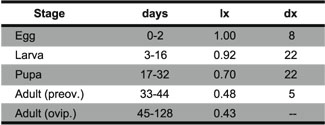
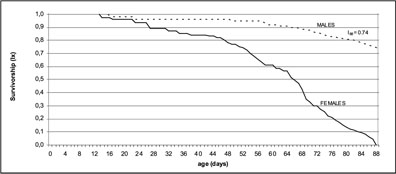
Figure 1. Survivorship (lx) of males and females of a lab strain of A. fraterculus (Tucumán, Argentina).
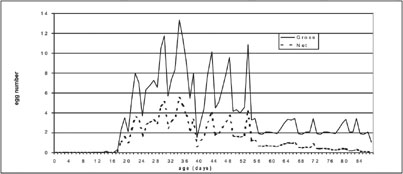
Figure 2. Daily gross and net fertility of a lab strain of A. fraterculus (Tucumán, Argentina 1998).
Adult reproduction
Gross fecundity1 rate was 328.4, net fecundity2 (Carey, 1982, 1984) rate was 120.4, and the average number of eggs laid per day was 2.1. Gross and net fecundity schedules are shown in Table 2 and Figure 2.
Table 2. Reproductive parameters for mass-reared A. fraterculus (Tucumán, Argentina).

Figure 3 shows the daily parities. Egg production was heterogeneous: 74% of the females laid at least 1 egg, but few females achieved more than 30 eggs/day. Considering all the females that lived (up to 88 days), 32% laid more than 500 eggs, 38% between 251 to 500, and 30% less than 251 (Figure 4).
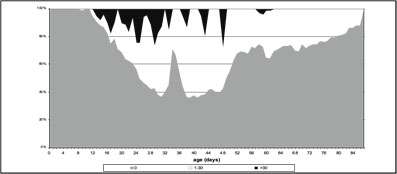
Figure 3. Daily parity classes of mass-reared A. fraterculus, showing the proportion of females producing 0, 1-30 and >30 eggs per day (Tucumán, Argentina, 1998).

Figure 4. Cumulative parity classes of mass-reared A. fraterculus, showing the proportion of females that attained the production of 0, 1-250, 250-500 and >500 eggs until death (Tucumán, Argentina).
Life table parameters
Intrinsic rate of increase, (rm)3 (Carey, 1993), was estimated to be 0.065. Mean generation time4 was 73.4 days. Based on these parameters, the population would double every 10.6 days. In a stable population, 22% would be eggs, 53% larvae, 18% pupae, 4% preoviposition adults and 3% reproductive adults (Table 3).
1 Gross fecundity: average total number of eggs a newborn fly will lay if it survives to the last day of reproduction.
2 Net fecundity: average total number of eggs a newborn fly will lay considering survivorship to the last day of reproduction.
3 Intrinsic rate of increase: it is the instantaneous rate of change (per individual per time interval), assuming the population presents a stable age distribution.
4 Mean generation time: mean age recorded in the reproduction of a cohort of females that laid one-half of all the eggs they can lay.
Table 3. Population parameters for mass-reared A. fraterculus (Tucumán, Argentina).
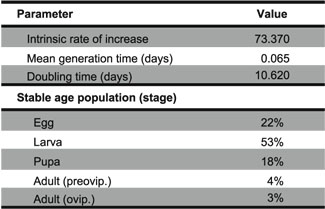
Discussion
Most laboratory-reared species have higher reproductive rates, earlier reproduction, and shorter life spans than wild strains. Larval hosts affect demographic parameters of fruit flies, too (Liedo and Carey, 1995).
Sugayama et al. (1998) estimated demographic parameters in apple and guava orchards. They found that at similar temperatures there are not any differences between larval and pupal developmental times of guava and apple-fed flies (Brazil), nor of flies reared on artificial diet in Tucumán. Results showed that larval mortality of mass-reared A. fraterculus was lower than that found in guava and apple-fed wild flies. Larval mortality under artificial rearing conditions was 22% compared with 45% and 57% in guava and apple-fed flies, respectively. Net fecundity rate was very different, with 120.4 for artificial rearing compared with 74.1 for feeding on guava. Mean generation time was similar for artificially reared flies and those feeding on guava. The doubling time for those artificially reared (10.6 days) was different compared with the value obtained for rearing on guava (18.2 days). The intrinsic rate of increase for rearing was 0.065 in the laboratory, a little higher than the guava value for wild flies, 0.053.
Adult oviposition, gross fecundity rate, net fecundity rate, eggs/female/day, and intrinsic rate of increase are each significantly different comparing wild flies reared on guava (Tucumán, Argentina) with mass-reared flies (see Table 4).
Table 4. Statistical analysis of several parameters of mass-reared A. fraterculus (Tucumán, Argentina, 1998).
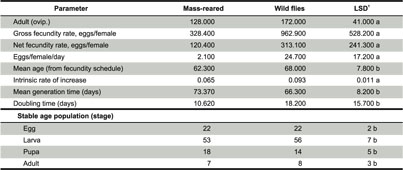
1LSD: Least Significant Difference.
a: There are significant differences at the 5% level (t test).
b: There are no significant differences at the 5% level (t test).
Compared with other species from different genera, mass-reared A. fraterculus had an intrinsic rate of increase lower than those of C. capitata (Wiedemann) (0.10), B. cucurbitae (Coquillet) (0.15), and B. dorsalis (Hendel) (0.16). (Vargas et al., 1984; Vargas and Nishida, 1985).
Compared with species from the same genus, the intrinsic rate of increase was very similar to those for A. ludens (0.047), A. serpentina (0.061) and A. obliqua (0.045) (Celedonio et al., 1988; Liedo and Carey, 1995; Harris et al., 1991).
Conclusion
Demographic data indicate that A. fraterculus has similar biological parameter rates compared to other species of the Anastrepha genus, but has lower biotic potential and is less injurious to fruit commodities than B. cucurbitae, B. dorsalis and C. capitata. The last one constitutes the main fruit fly problem in Argentina.
Cited references
1.Aluja, M. 1994. Bionomics and management of Anastrepha. Annu. Rev. Entomol. 39: 155-178.
2.Baker, E. W. 1945. Studies on the Mexican fruitfly known as Anastrepha fraterculus. J. Econ. Entomol. 38 (1): 95-100.
3.Barros, M. D.; M. Novaes e A. Malavasi. 1983. Estudos do comportamento de oviposiçao de Anastrepha fraterculus (Wiedmann, 1830) (Diptera, Tephritidae) em condiçoes naturais e de laboratorio. An. Soc. Entomol. Brasil. 12 (2): 243-247.
4.Carey, J. R. 1982. Demography and population dynamics of the Mediterranean fruit fly. Ecol. Model. 16: 125-150.
5.Carey, J. R. 1984. Host- specific demographic studies of the Mediterranean fruit fly Ceratitis capitata. Ecol. Model. 9: 261-270.
6.Carey, J. R. 1993. Applied demography for biologists with special emphasis on insects. Oxford University Press, England.
7.Celedonio, H.; P. Liedo; M. Aluja and J. Guillen. 1988. Demography of Anastrepha ludens, A. obliqua and A. serpentina (Diptera: Tephritidae) in Mexico. Fla. Entomol. 71 (2): 111-120.
8.González, J. E.; C. Vargas y B. Jara. 1971. Estudios sobre la aplicación de la técnica de machos estériles en el control de la mosca sudamericana de la fruta, Anastrepha fraterculus (Wied.). Rev. Peru. Entomol. 14 (1): 66-86.
9.Harris, E. J.; J. R. Carey; D. A. Krainacker and C. Y. L. Lee. 1991. Life history of Ceratitis capitata (Diptera: Tephritidae) reared from mock orange in Hawaii. Environ. Entomol. 20 (4): 1048-1052.
10.Hernández-Ortiz, V. 1992. El género Anastrepha en México. Taxonomía, distribución y sus plantas huéspedes. Instituto de Ecología, Xalapa, México.
11.Jaldo, H. E. 2001. Estudios biológicos y poblacionales de Anastrepha fraterculus (Diptera: Tephritidae). Tesis doctoral inédita. FAZ, UNT, Tucumán, Argentina.
12.Jaldo, H. E.; M. C. Gramajo and E. Willink . 2001. Mass rearing of Anastrepha fraterculus (Dip.: Tephritidae): a preliminary strategy. Fla. Entomol. 84 (4): 716-718.
13.Liedo, P. and J. R. Carey. 1994. Mass rearing of Anastrepha (Diptera:Tephritidae) Fruit Flies: A Demographic Analysis. J. Econ. Entomol. 87 (1): 176-180.
14.Liedo, P. and J. R. Carey. 1995. Demography of fruit flies and implications to action programs. In: McPheron, B.A. and G.J. Gary Steck (eds.), Fruit Flies: a world assessment of their biology and management, St. Lucie, Delray Beach, Florida, USA, pp. 299-308.
15.Liedo, P.; J. R. Carey, H. Celedonio and J. Guillen. 1992. Size specific demography of three species of Anastrepha fruit flies. Ent. Exp. Appl. 63: 135-142.
16.Malavasi, A. and J. S. Morgante. 1981. Adult and larval population of Anastrepha fraterculus and its relationship to host availability. Environ. Entomol. 10: 275-278.
17.Rust, E. W. 1918. Anastrepha fraterculus Wied. (Trypetidae). A severe menace to the Southern United States. J. Econ. Entomol. 11: 457-467.
18.Salles, L. A. B. 1992. Metodologia de criação de Anastrepha fraterculus (Wied., 1830) (Diptera: Tephritidae) em dieta artificial em laboratório. Anais Soc. Entomol. Bras. 21 (3): 479-486.
19.Salles, L. A. B. 1993 a. Influencia do fotoperiodo no desenvolvimento de Anastrepha fraterculus (Wied., 1830) (Diptera: Tephritidae). Anais. Soc. Entomol. Bras. 22 (1): 47-55
20.Salles, L. A. B. 1993 b. Efeito da temperatura constante na oviposicao e no ciclo de vida de A. fraterculus (Wiedemann) (Diptera: Tephritidae). Anais. Soc. Entomol. Bras. 22 (1): 57-62.
21.Sugayama, R. L.; A. Kovaleski; P. Liedo and A. Malavasi. 1998. Colonization of a new fruit crop by Anastrepha fraterculus (Diptera: Tephritidae) in Brazil: a demographic analysis. Environ. Entomol. 27: 642-648.
22.Vargas, R. I.; D. Miyashita and T. Nishida. 1984. Life history and demographic parameters of three laboratory-reared tephritids (Diptera: Tephritidae) Ann. Entomol. Soc. Am. 77: 651-656.
23.Vargas, R. I. and T. Nishida. 1985. Life history and demographic parameters of Dacus latifrons (Diptera: Tephritidae). J. Econ. Entomol. 78: 1242-1244.
24.Weems, H. V. 1980. Anastrepha fraterculus (Wiedemann) (Diptera: Tephritidae). Entomol. Circ. (Gainesv.) (217).
25.White, I. M. and M. M. Elson-Harris. 1992. Fruit flies of economic significance: their identification and bionomics. CAB International and ACIAR, Camberra, Australia. [ Links ] [ Links ] [ Links ] [ Links ] [ Links ] [ Links ] [ Links ] [ Links ] [ Links ] [ Links ] [ Links ] [ Links ] [ Links ] [ Links ] [ Links ] [ Links ] [ Links ] [ Links ] [ Links ] [ Links ] [ Links ] [ Links ] [ Links ] [ Links ] [ Links ]














